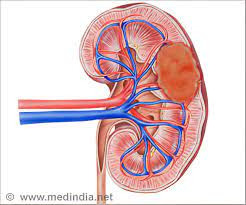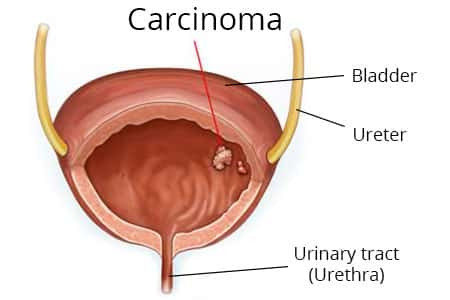Definisi
Karsinoma sel renal adalah kanker pada lapisan tubular (saluran yang sangat kecil) ginjal. Tubulus kecil ginjal berfungsi untuk menyaring dan membersihkan darah. Tubulus akan menyaring zat buangan dan membentuk urin. Setelah itu, urin akan mengalir dari kedua ginjal melalui saluran panjang yang disebut ureter ke dalam kandung kemih. Kandung kemih akan menampung urin sampai urin dikeluarkan dari tubuh melalui uretra. Kanker yang berasal dari ureter atau pelvis ginjal (bagian ginjal yang menampung urin dan mengalirkannya ke ureter) berbeda dengan karsinoma sel renal.
Karsinoma sel renal menyumbang 90% dari seluruh keganasan ginjal. Angka kejadian paling tinggi di negara Barat.
Penyebab
Para ahli belum mengetahui pasti penyebab karsinoma sel renal. Namun, kebanyakan kanker ginjal muncul ketika terdapat kelainan gen atau DNA ginjal.
Faktor Risiko
Faktor yang meningkatkan risiko terjadinya karsinoma sel renal adalah:
- Merokok. Merokok meningkatkan risiko karsinoma sel renal sebanyak dua kali lipat
- Penyalahgunaan obat-obatan anti nyeri dalam jangka panjang
- Obesitas, terutama pada perempuan
- Tekanan darah tinggi
- Riwayat keluarga dengan karsinoma sel renal
- Jenis kelamin pria. Rasio pria disbanding wanita adalah 1.5:1
- Memiliki kondisi genetik tertentu, seperti penyakit von Hippel-Lindau atau karsinoma sel renal papiler herediter
Memiliki faktor risiko bukan berarti Anda akan terkena kanker, begitu juga sebaliknya.
Gejala
Gejala dan tanda karsinoma sel renal dapat juga ditemukan pada kondisi lain. Pada stadium awal dapat tidak ditemukan gejala atau tanda. Gejala biasanya timbul seiring pertumbuhan tumor, yang meliputi:
- Darah pada urin
- Benjolan di perut
- Nyeri di pinggang atau sisi tubuh yang tidak kunjung hilang
- Kehilangan nafsu makan
- Penurunan berat badan yang tidak diketahui penyebabnya
- Anemia (kurang sel darah merah)
Diagnosa
Karsinoma sel renal didiagnosa dengan pemeriksaan terhadap perut dan ginjal. Pemeriksaan dan prosedur yang mungkin dilakukan adalah:
- Pemeriksaan fisik dan riwayat kesehatan. Dokter akan melakukan pemeriksaan fisik untuk menilai kesehatan secara umum, termasuk untuk mencari adanya tanda penyakit kanker ini seperti benjolan atau tanda lainnya yang tidak normal
- Prosedur ini menggunakan gelombang suara energi tinggi (ultrasound). Gelombang ini akan memantul dari organ dalam dan membentuk echo. Echo akan membentuk gambar jaringan tubuh
- Pemeriksaan kimia darah. Prosedur ini dilakukan dengan mengambil sampel darah untuk diperiksa jumlah zat tertentu yang dikeluarkan oleh organ dan jaringan tubuh. Adanya jumlah zat yang abnormal (lebih tinggi atau lebih rendah) dapat menunjukan adanya penyakit
- Pemeriksaan urin untuk mengecek warna urin dan kandungannya, seperti gula, protein, sel darah merah, dan sel darah putih
- CT scan. Prosedur ini akan menunjukkan serial gambar yang detail dari bagian dalam tubuh, seperti perut dan panggul, yang dapat dilihat dari sudut yang berbeda-beda. Zat kontras dapat juga disuntikan ke dalam vena atau ditelan untuk membantu organ atau jaringan agar tampak lebih jelas.
- MRI. Prosedur ini menggunakan magnet, gelombang radio, dan komputer untuk menghasilkan serial gambaran area dalam tubuh dengan detail
- Biopsi. Untuk melakukan biopsi, sebuah jarum tipis akan dimasukan ke dalam tumor dan sampel jaringan akan ditarik. Sampel tersebut selanjutnya akan diperiksa di bawah mikroskop oleh ahli patologi untuk mengecek adanya tanda kanker
Setelah karsinoma sel renal terdiagnosa, dokter akan melakukan pemeriksaan tambahan untuk menentukan apakah sel kanker sudah menyebar di dalam ginjal atau ke bagian tubuh lainnya. Hal ini dilakukan untuk menentukan stadium penyakit yang penting untuk merencanakan terapi. Tes dan prosedur yang digunakan adalah:
- CT scan atau MRI pada beberapa area seperti dada atau otak.
- X-ray dada
- Scan tulang. Prosedur ini digunakan untuk mengecek adanya sel yang membelah secara cepat, seperti sel kanker, pada tulang. Materi radioaktif yang sangat kecil akan disuntikan ke vena dan mengalir di dalam pembuluh darah. Materi radioaktif ini akan terkumpul di dalam tulang dengan kanker dan akan terdeteksi oleh scanner.
Tata Laksana
Terdapat beberapa jenis terapi yang berbeda untuk karsinoma sel kanker. Pilihan terapi untuk karsinoma sel renal tergantung pada stadium penyakit, usia, dan kesehatan secara umum. Lima jenis terapi standar yang digunakan adalah:
- Operasi. Operasi untuk membuang sebagian atau seluruh ginjal sering digunakan untuk menangani karsinoma sel renal.
- Terapi radiasi. Terapi ini menggunakan X-ray energi tinggi atau jenis radiasi lain untuk membunuh sel kanker atau mencegahnya bertumbuh. Terapi radiasi eksternal menggunakan mesin di luar tubuh untuk menghantarkan radiasi menuju area tubuh dengan kanker. Terapi radiasi eksternal juga digunakan untuk terapi paliatif yang bertujuan untuk memperbaiki gejala dan meningkatkan kualitas hidup, bukan untuk menyembuhkan penyakit.
- Kemoterapi. Kemoterapi adalah terapi kanker yang menggunakan oabt-obatan untuk menghentikan pertumbuhan sel kanker, baik dengan membunuh sela tau menghentikan pembelahannya. Kemoterapi dapat diberikan dengan ditelan atau disuntikan ke dalam vena atau otot, dimana obat akan masuk ke aliran darah dan dapat mengakses sel kanker di seluruh bagian tubuh
- Imunoterapi. Imunoterapi menggunakan system imun pasien untuk melawan kanker. Zat yang diproduksi oleh tubuh atau dibuat di laboratorium digunakan untuk meningkatkan, mengarahkan, dan memulihkan pertahanan alami tubuh melawan kanker. Terapi kanker ini merupakan salah satu jenis dari terapi biologis
- Terapi target. Terapi ini menggunakan obat-obatan atau zat lain yang dapat mengidentifikasi dan menyerang sel kanker spesifik. Terapi target biasanya menyebabkan kerusakan sel normal yang lebih minimal dibandingkan dengan kemoterapi atau terapi radiasi.
Komplikasi
Komplikasi karsinoma sel renal adalah:
- Ketika kanker menyebar ke bagian tubuh lainnya, hal ini disebut metastasis. Tumor pada metastasis merupakan tipe kanker yang sama dengan tumor awal. Sebagai contoh, jika karsinoma sel renal menyebar ke tulang, sel kanker yang ada di tulang merupakan sel karsinoma renal. Penyakitnya disebut dengan karsinoma sel renal metastasis, bukan kanker tulang. Sel kanker dapat lepas dari tempat asalnya dan menyebar melalui:
- Kanker menyebar dari tempat asalnya ke area sekitarnya
- Sistem pembuluh getah bening (limfatik). Kanker menyebar dari tempat asalnya ke bagian tubuh lain melalui pembuluh getah bening
- Kanker menyebar ke bagian tubuh lainnya melalui pembuluh darah
- Gangguan fungsi ginjal yang dapat fatal jika tidak dilakukan dialysis (cuci ddarah) atau operasi
- Karsinoma sel renal dapat kambuh beberapa tahun setelah terapi awal.
Selain komplikasi dari kanker, komplikasi juga dapat timbul dari terapi kanker.
Pencegahan
Meskipun tidak ad acara yang terbukti dapat mencegah kanker ginjal, namun Anda dapat menurunkan risiko dengan cara:
- Berhenti merokok
- Mengontrol tekanan darah
- Menjaga berat badan ideal
- Diet tinggi buah dan sayuran serta rendah lemak
Kapan Harus ke Dokter?
Jika Anda mengalami gejala karsinoma sel renal, maka Anda harus berkonsultasi dengan dokter.
Mau tahu informasi seputar penyakit lainnya? Cek di sini, ya!
- dr Anita Larasati Priyono
Renal Cell Cancer Treatment (PDQ®)–Patient Version. (2022). Retrieved 29 June 2022, from https://www.cancer.gov/types/kidney/patient/kidney-treatment-pdq
Renal Cell Carcinoma: Practice Essentials, Background, Pathophysiology. (2022). Retrieved 29 June 2022, from https://emedicine.medscape.com/article/281340-overview#a4
Symptoms of Renal Cell Carcinoma. (2022). Retrieved 29 June 2022, from https://www.verywellhealth.com/symptoms-of-renal-cell-carcinoma-5202586#toc-complications
Kidney Cancer - Risk Factors and Prevention. (2022). Retrieved 29 June 2022, from https://www.cancer.net/cancer-types/kidney-cancer/risk-factors-and-prevention
EAU Guidelines on RCC - EPIDEMIOLOGY AETIOLOGY AND PATHOLOGY - Uroweb. (2022). Retrieved 29 June 2022, from https://uroweb.org/guidelines/renal-cell-carcinoma/chapter/epidemiology-aetiology-and-pathology








